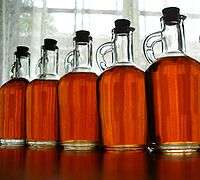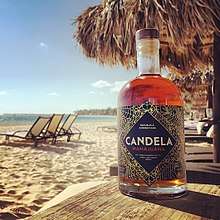Liqueur
A liqueur (US: /lɪˈkɜːr/ or UK: /lɪˈkjʊər/) is an alcoholic beverage made from a distilled spirit that has been flavored with fruit, cream, herbs, spices, flowers or nuts and bottled with added sugar or other sweetener (such as high-fructose corn syrup). Liqueurs are typically quite sweet; they are usually not aged for long after the ingredients are mixed, but may have resting periods during their production to allow flavors to marry.
In the United States and Canada, where spirits are often called "liquor" (pronounced /ˈlɪkər/, with stress on the first rather than the second syllable), there is often confusion over liqueurs and liquors, especially as many spirits today are available in flavored form (e.g. flavored vodka). Most liqueurs have a lower alcohol content (15–30% ABV) than spirits, but some contain as much as 55% ABV.
In parts of the United States and Canada, liqueurs may also be called cordials or schnapps,[1][2][3][4] while in parts of the Commonwealth of Nations, cordial means a concentrated non-alcoholic fruit syrup that is diluted to taste and consumed as a non-carbonated soft drink. In Germany and Scandinavia, schnapps means a form of brandy or aquavit.
History
Liqueurs are historical descendants of herbal medicines; they were made in Italy as early as the 13th century and were often prepared by monks (e.g. Chartreuse).
Nowadays, liqueurs are made worldwide and are served in many ways: by themselves, poured over ice, with coffee, mixed with cream or other mixers to create cocktails, etc. They are often served with or after a dessert. Liqueurs are also used in cooking.
Some liqueurs are prepared by infusing certain woods, fruits, or flowers in either water or alcohol and adding sugar or other items. Others are distilled from aromatic or flavoring agents. Anise liqueurs have the interesting property of turning from transparent to cloudy when added to water: the oil of anise remains in solution in the presence of a high concentration of alcohol, but crystallizes when the alcohol concentration is reduced; this is known as the ouzo effect.
Layered drinks are made by floating different-colored liqueurs in separate layers. Each liqueur is poured slowly into a glass over the back of a spoon or down a glass rod, so that the liquids of different densities remain unmixed, creating a striped effect.
The French word liqueur comes from the Latin liquifacere ("to liquefy").
- Liqueurs
 Bottles of homemade strawberry liqueur
Bottles of homemade strawberry liqueur- Herbal liqueur produced in Austria and bottled at 38% ABV

 Demänovka is a traditional Slovak liqueur produced since 1867.
Demänovka is a traditional Slovak liqueur produced since 1867.
 Candela is Dominican liqueur, called Mamajuana, made by the Taino Indians since the early 1500s.
Candela is Dominican liqueur, called Mamajuana, made by the Taino Indians since the early 1500s.
Legal definitions
Canadian regulations
Under the Food and Drug Regulations (C.R.C., c. 870), liqueurs are produced from mixing alcohol with plant materials. These materials include juices or extracts from fruits, flowers, leaves or other plant materials. The extracts are obtained by soaking, filtering or softening the plant substances. A sweetening agent should be added in an amount that is at least 2.5 percent of the finished liqueur. The alcohol percentage shall be at least 23%. It may also contain natural or artificial flavouring and colour.[5]
See also
References
- ↑ What are Schnapps and Cordials? Retrieved 2012-05-28
- ↑ Lichine, Alexis (1987). Alexis Lichine's New Encyclopedia of Wines & Spirits (5th ed.). New York: Alfred A. Knopf. p. 198. ISBN 0-394-56262-3.
- ↑ New Oxford American Dictionary (3rd ed.). New York: Oxford University Press. 2010. p. 385. ISBN 978-0-19-539288-3. cordial: "another term for liqueur"
- ↑ "The Cook's Thesaurus". Retrieved October 11, 2010.
- ↑ Branch, Legislative Services. "Consolidated federal laws of canada, Food and Drug Regulations". laws.justice.gc.ca.
External links
| Look up liqueur in Wiktionary, the free dictionary. |
| Wikimedia Commons has media related to Liqueur. |
- Liqueurs at The Cook's Thesaurus.



